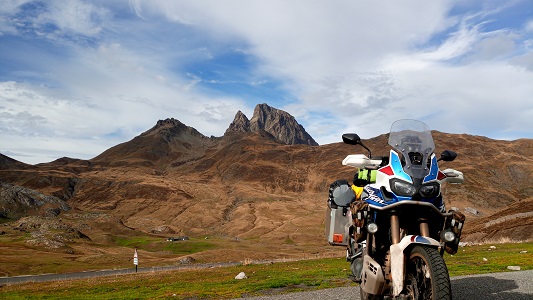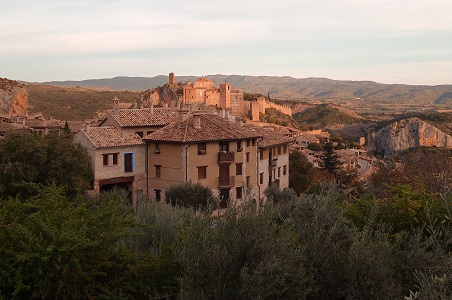 Even if I only drove a little bit over the Pyrenees, it was great. The landscape is unique, the streets are good and wonderful for riding a motorcycle. I arrived at Alquézar in the evening. In France I had already looked for a cheap hostel in town, but hadn't booked it yet. Once there, the hostel looked closed, so I called to ask for a room. The ladiy on the phone didn't speak English and I tried to ask with my few Spanish words. There were no rooms available, or the woman didn't feel like housing someone who didn't speak Spanish. I dont know. What now? It was getting dark. I found an information board showing the local hostels and hotels. And there was "Refugio", so I went there to ask for a room. Again, they hardly spoke English, but a little French. After I checked in, I ordered a beer at the Refugio's bar and asked about a cheap and good restaurant. Pilar was also sitting at the bar. She spoke English and we started talking. Pilar accompanied me to dinner. We went to a small restaurant, ordered something to eat and spoke about this and that. A really good start for my trip through Spain. Nice food and very nice company.
Even if I only drove a little bit over the Pyrenees, it was great. The landscape is unique, the streets are good and wonderful for riding a motorcycle. I arrived at Alquézar in the evening. In France I had already looked for a cheap hostel in town, but hadn't booked it yet. Once there, the hostel looked closed, so I called to ask for a room. The ladiy on the phone didn't speak English and I tried to ask with my few Spanish words. There were no rooms available, or the woman didn't feel like housing someone who didn't speak Spanish. I dont know. What now? It was getting dark. I found an information board showing the local hostels and hotels. And there was "Refugio", so I went there to ask for a room. Again, they hardly spoke English, but a little French. After I checked in, I ordered a beer at the Refugio's bar and asked about a cheap and good restaurant. Pilar was also sitting at the bar. She spoke English and we started talking. Pilar accompanied me to dinner. We went to a small restaurant, ordered something to eat and spoke about this and that. A really good start for my trip through Spain. Nice food and very nice company.
The next day my trip went on trough hilly landscapes and small roads to Logroño. A big city in the La Rioja region. In the evening I walked around, ate something and went to sleep. It went further north over the mountains and hills. Great landscapes and good roads. It was planned that I should meet Manuel and that we would go to Santiago de Compostela together. We met at Atlantic Ocean Road in Norway in August and have been in touch ever since. Unfortunately bad weather started in the north and we decided to meet in Madrid and drive south. Before we met I drove through the Los Picos de Europa National Park. A paradise for motorcyclists. Gorges, curves, mountains ... Hardly a moment in which the motorcycle was not driven in an inclined position. That day I drove to Burgos and stayed in a cheap hotel on the outskirts. The following day I visited Burgos on foot in nice sunshine. Burgos has some wonderful Gothic buildings, especially the cathedral. I continued to Brunete, near Madrid. The route was relatively boring. Almost only straight lines, few curves, but you made good progress. Shortly before the goal drove over a mountain, this was the most interesting part of the day. Nothing was going on in Brunete. I ate something and went to sleep. Manuel and I met the next day. We met at his house, had a coffee and talked a little about our experiences since August. Then we made our way towards Murcia. We had cross winds all day, but it wasn't a problem to drive. We stopped for coffee and drove on. When the hunger was slowly noticeable, we stopped at a small restaurant in the middle of nowhere and enjoyed a good "Menu del dia". These menus can be found all over Spain. For 8-10 euros you get a small starter, main course, dessert and a drink. Since it was almost mid-afternoon, we decided not to drive to Murcia, but only to Albecete. The blade city of Spain. Manuel had already decided to go back to Madrid in the evening to avoid the strong wind the next day. But first we went for a walk through the city and visited a museum with a free exhibition. When we strolled through the park and looked up at the sky, there was a mass of birds in the air. The swarms almost darkened the sky, there were so many birds. 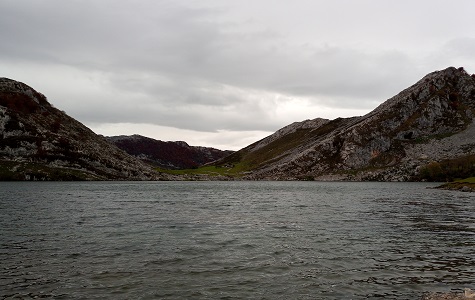 Almost scary, but a real natural splendor. Manuel had already gone back to Madrid the previous evening and I was on my way to Murcia. However, the wind was so strong that I had to stop after two hours. Although it was not as strong as the gusts of wind that I had experienced at Malin Head in Ireland, it still blew constantly at almost 50 km / h and I it was a real struggle to drive. So I stopped in a small town and made myself comfortable in a restaurant, had a drink, ate and checked the weather on the Internet. After five hours the wind seemed to have calmed down and I kept driving, but it was still too strong and after 40 minutes I stopped again and waited a little more than an hour. When the calmed down I drove on to Hellin and from there there was hardly any wind. Refuel and continue to Murcia.
Almost scary, but a real natural splendor. Manuel had already gone back to Madrid the previous evening and I was on my way to Murcia. However, the wind was so strong that I had to stop after two hours. Although it was not as strong as the gusts of wind that I had experienced at Malin Head in Ireland, it still blew constantly at almost 50 km / h and I it was a real struggle to drive. So I stopped in a small town and made myself comfortable in a restaurant, had a drink, ate and checked the weather on the Internet. After five hours the wind seemed to have calmed down and I kept driving, but it was still too strong and after 40 minutes I stopped again and waited a little more than an hour. When the calmed down I drove on to Hellin and from there there was hardly any wind. Refuel and continue to Murcia.
I spent a few days in Murcia. I had a look around the city, got new brake blocks for my motorcycle, updated my homepage and planned my next days. Before the winter stop I wanted to go to Portugal. So I headed north again. The landscape in the center of Spain is mostly flat with few curves. You make kilometers, but it is not really exciting. Only further to the west the hills begin again and the roads become more winding. I spent my last night in Spain in Cáceres. The old town is a UNESCO World Heritage Site and if you stroll through the narrow streets you can see why. It reminded me a little of Urbino (I). The age of the city is noticeable when you look at the buildings. There is even a small Arab museum. During the renovation, the founder of the museum found various evidence that the Arabs were there and decided to turn his house into a museum.
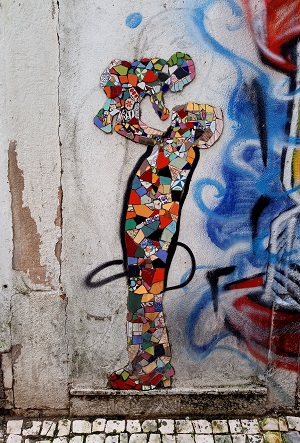 From Cáceres I went on to Coimbra in Portugal. I stopped at the Alcantara bridge. The bridge was built around AD 100 by the Romans. I came to Portugal over a small arch bridge. It was still dry and I was making good progress. The navigation system slowly led me to Coimbra via small winding paths. For a while I only had burned forests to my left and right. When I drove over the hills it started to rain. I checked again the route on the nav sat and corrected it to get to Coimbra as quickly as possible. The hostel was a large villa near the center. It was already November and it had just a few guests. In the hostel I met Chrissi. She is from South Korea and visited Portugal for a few days. We visited part of the city together, then she went to the library and I visited the rest of the city. We met later and went to dinner together. It is always interesting to meet people from other parts of the world, especially if they come from a completely different culture. Before Chrissi continued her trip, she gave me a hand-knitted lucky charm, a little green cap. She went on to Porto and I stayed in Coimbra for another day before driving on to Nazaré.
From Cáceres I went on to Coimbra in Portugal. I stopped at the Alcantara bridge. The bridge was built around AD 100 by the Romans. I came to Portugal over a small arch bridge. It was still dry and I was making good progress. The navigation system slowly led me to Coimbra via small winding paths. For a while I only had burned forests to my left and right. When I drove over the hills it started to rain. I checked again the route on the nav sat and corrected it to get to Coimbra as quickly as possible. The hostel was a large villa near the center. It was already November and it had just a few guests. In the hostel I met Chrissi. She is from South Korea and visited Portugal for a few days. We visited part of the city together, then she went to the library and I visited the rest of the city. We met later and went to dinner together. It is always interesting to meet people from other parts of the world, especially if they come from a completely different culture. Before Chrissi continued her trip, she gave me a hand-knitted lucky charm, a little green cap. She went on to Porto and I stayed in Coimbra for another day before driving on to Nazaré.
When I approached Nazaré, it looked as if the entire coast was covered in a fine mist. As it turned out, it wasn't fog, but the spray of the waves. Nazaré is particularly known in the surfing scene for the big waves. Waves over 30 meters high have already been measured. When I was there the waves didn't reach 30 meters, I guess they were "only" 10-12 meters. The biggest waves I had ever seen and there were also a few daring surfers in the water. They were dragged onto the waves by jet skis and rode down these giants. What a spectacle.
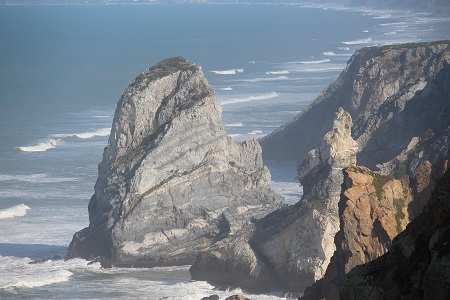 The next day I went on to Lisbon. I stayed in Estoril, just before Lisbon. Here too there were few guests in the hostel. During the days there I visited Lisbon, Cascais and of course Cabo da Roca, the westernmost point of the main Europe. All three places were full of tourists. I can well imagine that it can get really crowded in summer. Visiting the city in the off-season is definitely more pleasant. Fewer people, fewer queues and probably cheaper too.
The next day I went on to Lisbon. I stayed in Estoril, just before Lisbon. Here too there were few guests in the hostel. During the days there I visited Lisbon, Cascais and of course Cabo da Roca, the westernmost point of the main Europe. All three places were full of tourists. I can well imagine that it can get really crowded in summer. Visiting the city in the off-season is definitely more pleasant. Fewer people, fewer queues and probably cheaper too.
I spent the last days in Portugal in Albufeira. Several friends had raved about how wonderful it is there. Personally, it didn't really convince me. Everything is geared towards tourism and the hop-on hop-off bus tour also tells more about the different hotels and resorts than about the history of the place. Too bad.
The way to Spain led me over small winding roads to the border. From the border on I drove towards Seville on the motorway. The rain started short before of Seville and lasted until Cadiz.



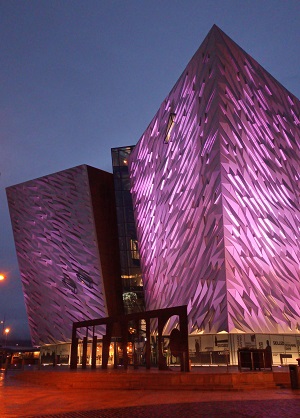 Arrived by ferry in Belfast, the trip went directly to the Youth Hostel. I checked in and made my way to the city center on foot. It was raining a bit and I looked at some of the sights on the way to the Titanic Museum. The most impressive was the Titanic Museum. A very modern building in an old city. At night, the facade is illuminated and the building looks even more impressive.
Arrived by ferry in Belfast, the trip went directly to the Youth Hostel. I checked in and made my way to the city center on foot. It was raining a bit and I looked at some of the sights on the way to the Titanic Museum. The most impressive was the Titanic Museum. A very modern building in an old city. At night, the facade is illuminated and the building looks even more impressive.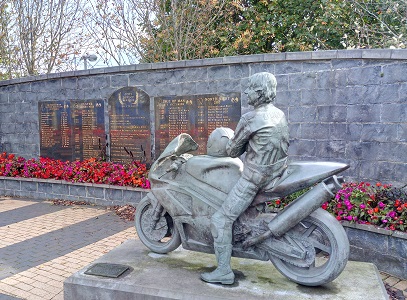 The next day I drove again along the coast. This time with the motorcycle. I took some photos that were not possible on the bus and drove to Ballymoney for the Dunlop Memorial. Almost every motorcyclist knows who Joey and Robert Dunlop were. And if there is a monument and you are in the area, you go there. For those of you who do not know, Joey and Robert Dunlop were two of the most successful road racers. Both were killed in such street races. Joey Dunlop near Tallinn in Estonia and Robert at a road race in Northern Ireland.
The next day I drove again along the coast. This time with the motorcycle. I took some photos that were not possible on the bus and drove to Ballymoney for the Dunlop Memorial. Almost every motorcyclist knows who Joey and Robert Dunlop were. And if there is a monument and you are in the area, you go there. For those of you who do not know, Joey and Robert Dunlop were two of the most successful road racers. Both were killed in such street races. Joey Dunlop near Tallinn in Estonia and Robert at a road race in Northern Ireland.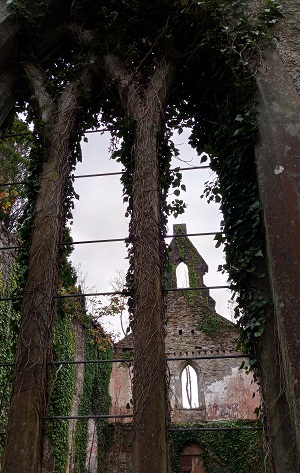 He sat down on my table and told me that Toby Price played football with his son when they were kids, and that he only had motorcycles in his head. Toby Price is a motocross rider and multiple Dakar winner. We talked for a while and the table neighbors started to talk to us. These said that earlier there was a road race passing trough Leitrim and Joey and Robert Dunlop were two of the drivers. At the end of the evening we said goodbye and I talked to a couple from Canada who visited Ireland by car.
He sat down on my table and told me that Toby Price played football with his son when they were kids, and that he only had motorcycles in his head. Toby Price is a motocross rider and multiple Dakar winner. We talked for a while and the table neighbors started to talk to us. These said that earlier there was a road race passing trough Leitrim and Joey and Robert Dunlop were two of the drivers. At the end of the evening we said goodbye and I talked to a couple from Canada who visited Ireland by car.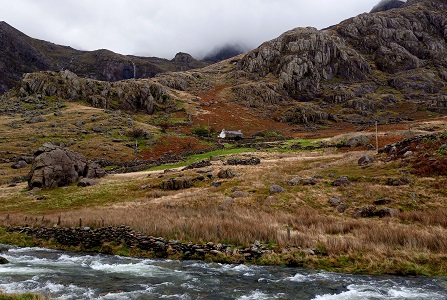 The visit to the dams took much more time than expected, so I looked for a place to stay and finally found something in Ross-on-Wye. London was the destination for the next day. On the way, I made a quick stop in Stow-on-the-Wold to see a door of St. Edward's Church. To the left and right of the door, the trees were so waxed that they became one with the door frame. In London I stayed in a hostel. With the tube I only had half an hour to the city center. The hostel was not right on the street and had a parking lot that was not visible to passers-by. A few weeks later, I was told that this area should be one of the least safe of London. I spent four days in England's capital and met Anschi from my swiss motorcycle group. She was just in London for a language course. Again, I attended a free-walking tour.
The visit to the dams took much more time than expected, so I looked for a place to stay and finally found something in Ross-on-Wye. London was the destination for the next day. On the way, I made a quick stop in Stow-on-the-Wold to see a door of St. Edward's Church. To the left and right of the door, the trees were so waxed that they became one with the door frame. In London I stayed in a hostel. With the tube I only had half an hour to the city center. The hostel was not right on the street and had a parking lot that was not visible to passers-by. A few weeks later, I was told that this area should be one of the least safe of London. I spent four days in England's capital and met Anschi from my swiss motorcycle group. She was just in London for a language course. Again, I attended a free-walking tour.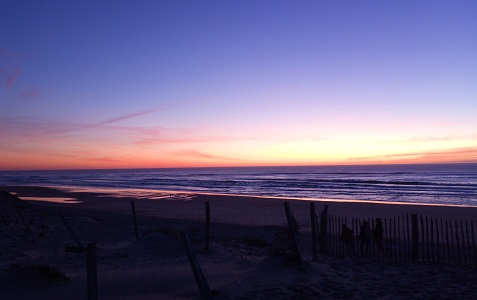 I stayed overnight in Cherbourg. France was more or less a thoroughfare. From Cherbourg I went to Avranches to see Mont-Saint-Michel the next day. The hill is about one kilometer in the Wadden Sea and years you had to pay attention to the tides to get on or off the hill. Meanwhile, there is a jetty that always guarantees access. The hill is dominated by the abbey at the top. On the way up to the abbey you pass numerous souvenir shops and restaurants. Everything in a huge crowd. Mont-Saint-Michel is visited annually by more than two million people. Nevertheless, it is impressive to see what people can build.
I stayed overnight in Cherbourg. France was more or less a thoroughfare. From Cherbourg I went to Avranches to see Mont-Saint-Michel the next day. The hill is about one kilometer in the Wadden Sea and years you had to pay attention to the tides to get on or off the hill. Meanwhile, there is a jetty that always guarantees access. The hill is dominated by the abbey at the top. On the way up to the abbey you pass numerous souvenir shops and restaurants. Everything in a huge crowd. Mont-Saint-Michel is visited annually by more than two million people. Nevertheless, it is impressive to see what people can build.